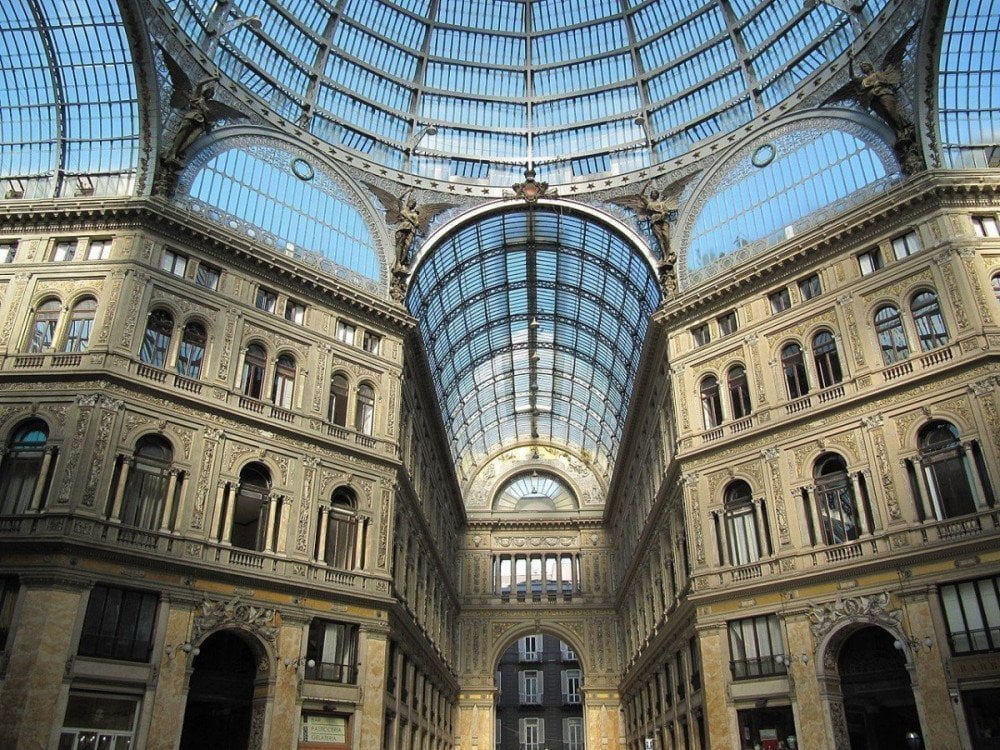The Galleria Umberto I in Naples is an elegant public space that stands out amidst the city’s confusion. Sheltered by a luminous glass and steel ceiling, it was Neapolitans’ meeting place during the Belle Époque. Today, this arcade hides historic shops and venues with an old-world charm.
Table of Contents
Why visit the Galleria Umberto I in Naples
The first impact with Naples is the hustle and bustle, pizza, markets and shouting in the streets. Naples is a noisy city that never stops. Its inhabitants always seem intent on eating, moving, and shopping. Behind the colour of Naples, however, lies a regal city that evokes the ancient splendours of theatres, castles, baroque churches and aristocratic palaces.
ORGANISE YOUR TRIP TO NAPLES
Get the Naples Pass to save money. The card gives you access to attractions like the underground city tour and the Catacombs of San Gennaro, and unlimited public transport during its validity.
To stay connected in Italy, remember to buy an Airalo eSim online, with data and phone coverage for your trip to Naples.
Imagine a 19th-century Naples in cultural ferment, a city through which nobles and intellectuals passed. A city that had nothing to envy the splendour of Milan or Turin, then capital of the Kingdom of Italy. The very architecture of the Galleria Umberto I echoes the styles of the Galleria Vittorio Emanuele II in Milan, built twenty years earlier. It also similar to the Galleria San Federico in Turin, built thirty years later.
The arcade redeveloped an unhealthy, working-class area in the city centre after the cholera epidemic of 1884. The Galleria Umberto I replaced overcrowded blocks of flats with four classy buildings linked by a shopping arcade, designed by engineer Emanuele Rocco.
From the end of the 19th century, the Galleria Umberto I thus became Naples’s ‘salotto buono’, as Italians call the house’s room dedicated to welcoming guests. In this place, gentlemen stopped to have their shoes shined by the ‘sciuscià’ while ladies went shopping, sheltered from the elements by the glass and steel dome. Apart from the disappearance of the shoe-shinners, Neapolitan bourgeois habits have not changed much. Today, you can stroll inside the Galleria Umberto I among the shop windows and enjoy a perfect Neapolitan espresso at the bar.

Galleria Umberto I interesting facts
Two covered streets intersecting under the glass and steel dome are inside the shopping arcade. The marble floor has a zodiac signs decoration. It is not the original from the late 19th century because the Galleria Umberto suffered heavy damage by bombing during World War II. Today’s flooring is from the 1952 renovation.
The Galleria Umberto I in Naples has four entrances located at different levels of the street level. Entrances are from Via San Carlo, Via Santa Brigida, Via Toledo and Vico Rotto San Carlo. For this reason, the stairs to enter the shopping arcade have different steps for each entrance. The Neapolitan capital is not flat, but neighbourhoods and streets are on different levels.
Each entrance to the Galleria Umberto I has an arch with different decorations. The main entrance facing Via San Carlo has four marble statues representing the areas of the known world. The vision is the stereotypical one of the time, with Africa represented by a banana helmet and a sphinx.
The underground theatre Salone Margherita
The Galleria Umberto I also includes an underground theatre, the Salone Margherita. Created to host chamber concerts, it was for a long time the most famous Neapolitan café-chantant. The entrance to the Salone Margherita is a few steps from Via Santa Brigida. The theatre was habitually frequented by nobles and intellectuals.
The Salone Margherita was inspired by Parisian café-chantants such as Moulin Rouge and Folies Bergère. It was the first theatre in Italy to offer a can-can show. Menus and palimpsests were in French, as the liveried waiters spoke French. Even the performers pretended to be French, choosing stage names inspired by Parisian stars and vedettes.
Where to stay in Naples
Naples boasts numerous accommodations, from hotels to seaside flats. With my frequent visits to Naples, I can suggest several options. For an authentic experience in the historic center, consider The Idyll Boutique Apartment in the Spanish Quarter. This charming flat features parquet floors and a fully equipped kitchen, conveniently close to major attractions. Alternatively, the upscale Relais Della Porta, situated on Via Toledo, places you a short distance from landmarks like the San Carlo Theatre. Last but not least, the Santa Chiara Boutique Hotel, located near the Dante metro stop, offers a continental or Italian breakfast to start your day.
Please share your thoughts in the comments if you know the Galleria Umberto I and the elegant 19th century Naples. It surprised me to discover this contrast with the colourful Naples that fascinates visitors today.
